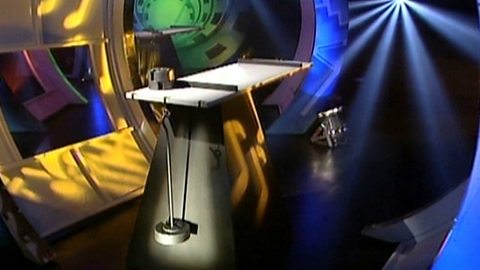Let's learn some circuit symbols that are often used in circuit diagrams.
Watch and learn
Video
What are circuit symbols used for? Let's find out.
The scientists are going to show us how electrical energy flows around an electrical circuit.
Title: Circuit symbols
This is what a battery looks like as a circuit symbol. Electricity can travel around the circuit.
Let’s add another component. This is what a bulb looks like as a symbol.
The electrical energy from the battery has been used to make the lamp turn on. The energy has been transferred to the lamp as light and heat.
When all the energy in the battery has been used, the battery has become discharged. There is no more electrical energy to power the lamp.
Let’s change the circuit again and add a switch. A switch turns the circuit on or off by completing or breaking the circuit loop.
Turning the switch on completes the circuit. Energy can flow and the lamp lights up. When the switch is tuned off, the circuit is open so the electrical energy stops flowing.
Circuit symbols are really useful when designing the electrical circuits inside the things we use. Circuit symbols help us to plan the circuits before we build them.
Here are some more useful circuit symbols:
A motor. This transforms electrical energy from the battery into mechanical movement.
A buzzer. This transforms electrical energy from the battery into sound energy.
A generator. This can replace a battery as a power source. A generator converts movement energy into electrical energy like a turbine.
A circuit diagram helps electrical engineers know what to build. Try building simple circuits with your friends and draw diagrams to match what you build.
It looks like our battery has run out of energy. The scientists have found a fix. A spinning bike wheel provides movement energy that a dynamo can turn into new electrical energy.
What is a circuit symbol?
A circuit symbol is a simple picture that is used to represent an electrical componentA device in an electric circuit, such as a battery, switch or lamp. when drawing a circuit diagram.
Each circuit symbol can be used to show a particular component, no matter what that component looks like.
Think about all the different types of battery you can get. Even though they all look very different, they are all represented by the same symbol.
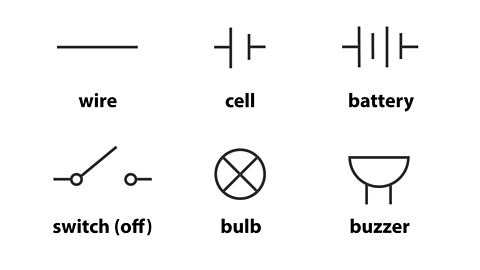
What is a circuit diagram?
A circuit diagram uses circuit symbols to show how components are connected in a circuit.
It doesn't show what the circuit actually looks like, or how long all the connections are.
It is a simplified picture that shows the following:
- what components are in the circuit
- how they are connected
- the order they are connected in

Image caption, This circuit diagram joins a cell, a switch and two bulbs. Click on the next slide to see what the circuit might look like if you built it.
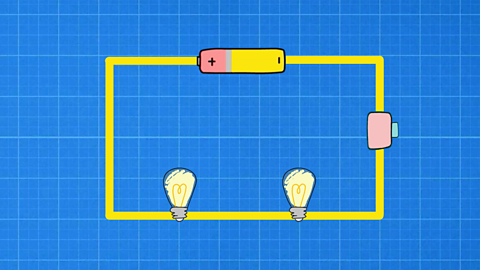
Image caption, This shows what the previous circuit diagram describes: a battery connected to two bulbs and a switch. This is not a circuit diagram.
1 of 2
Why do we need them?
The symbols used are an international standard which means a circuit diagram can be sent to any country in the world and be understood, regardless of the language spoken.
For example, a circuit designed in Scotland can be accurately built in Spain, even if the designer only speaks English and the person building the circuit only speaks Spanish.
Some common symbols

A wire
The wires in a circuit diagram are shown with solid lines.
Tip: They should be straight lines, so make sure you always use a ruler to draw them.


A cell
A circuit has to have a power source and that is often a cell.
The short line of the symbol is the negative terminal.
The longer line is the positive terminal.
Tip: You don’t have to draw the + and – symbols but they can be helpful.

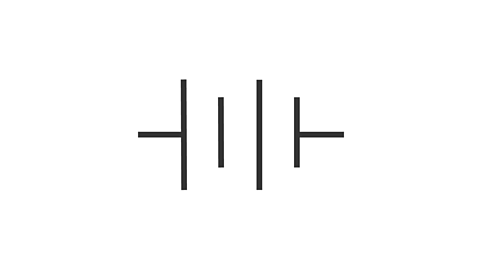
A battery
A battery is a power source made from more than one cell.
The symbol for a battery looks like two or more cells put together.
Tip: It is always important to check that batteries are used the right way round.

Light sources
In a light bulb electrical energy is converted into light energy and heat energy.
In an LED electrical energy is almost all converted into light energy with almost none wasted as heat.

Image caption, The bulb symbol is a circle with a cross through it.
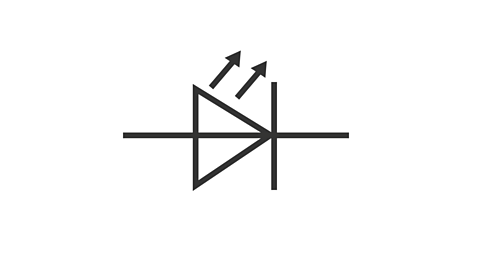
Image caption, The LED symbol is a triangle pointing to a straight line. Two arrows show light being emitted.
1 of 2
A switch
Circuits in real life almost always contain a switch so they can be turned on and off when needed.
It can be shown in:
- the open position (showing the light is off)
or
- the closed position (showing the light is on)
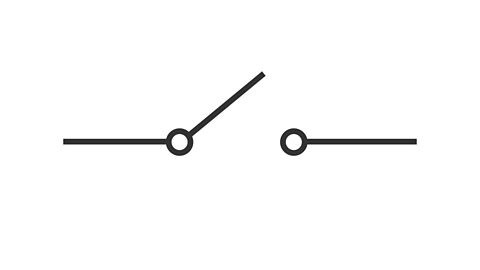
Image caption, The switch symbol (off) has a line at an angle to show the circuit has a opening and is not complete.
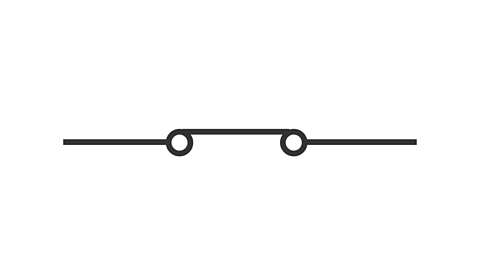
Image caption, The switch symbol (on) The circles show where the switch is. They are joined by a straight line showing the switch is closed and the circuit is complete.
1 of 2
Other useful symbols
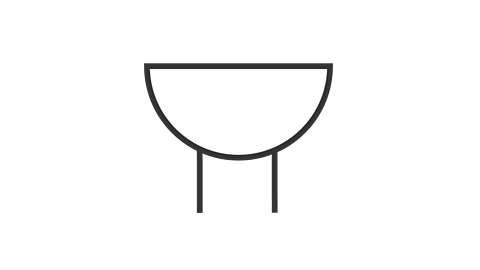
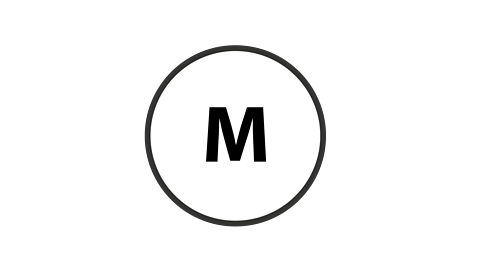
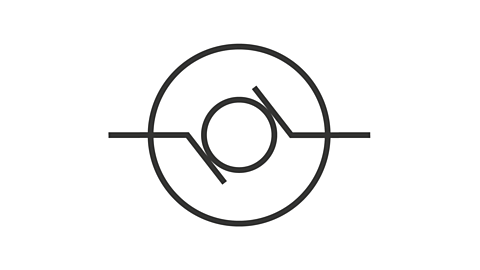
Activity
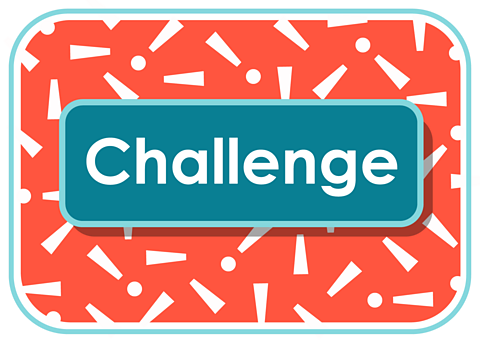
The circuit diagram challenge!
You will need:
a pencil and some paper
an electrical science kit with:
- a switch
- a bulb
- a battery
- a battery holder
- wires with crocodile clips
a partner to work with
Try designing a circuit diagram using these components. See if your partner can build the circuit using only your diagram.
Watch the video below to find out what to do.
Video
Watch this video to find out what to do!

Sorry, something went wrongCheck your connection, refresh the page and try again. – A drawing of an electrical circuit using symbols to show how components are connected in the circuit.
Sorry, something went wrongCheck your connection, refresh the page and try again. – A simple picture used to represent a component when drawing a circuit diagram.
Sorry, something went wrongCheck your connection, refresh the page and try again. – A type of electrical generator, often turned by hand, that can replace a battery in a circuit.
Sorry, something went wrongCheck your connection, refresh the page and try again. – A device in an electric circuit, such as a battery, switch or lamp.
Sorry, something went wrongCheck your connection, refresh the page and try again. – A light source that produces almost no heat. LED stands for 'Light Emitting Diode'.
Sorry, something went wrongCheck your connection, refresh the page and try again. – The ends of a battery. One end is positive and the other is negative.
Quiz
More on Electricity
Find out more by working through a topic
- count5 of 8
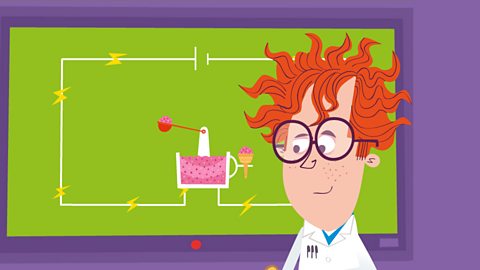
- count7 of 8

- count8 of 8
